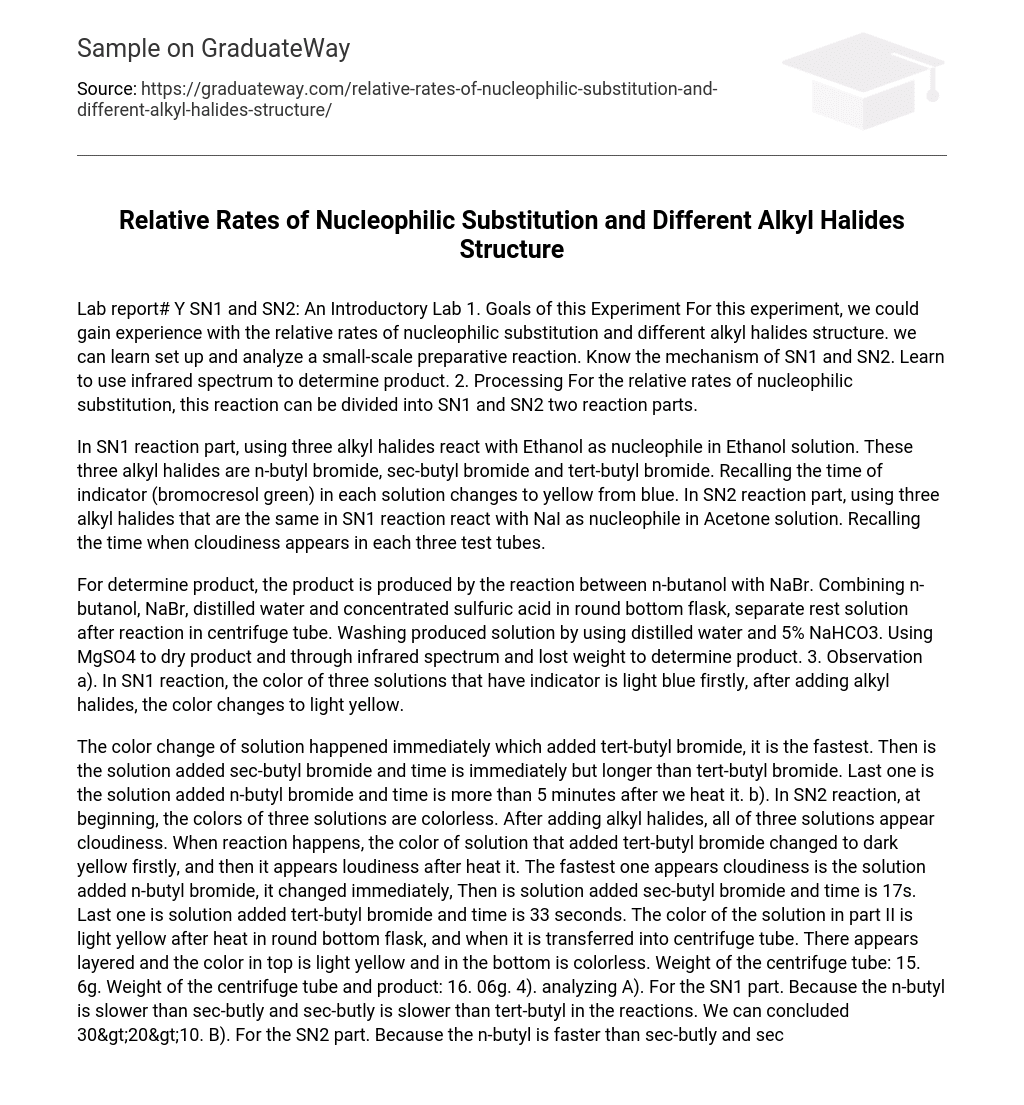Lab report# Y SN1 and SN2: An Introductory Lab 1. Goals of this Experiment For this experiment, we could gain experience with the relative rates of nucleophilic substitution and different alkyl halides structure. we can learn set up and analyze a small-scale preparative reaction. Know the mechanism of SN1 and SN2. Learn to use infrared spectrum to determine product. 2. Processing For the relative rates of nucleophilic substitution, this reaction can be divided into SN1 and SN2 two reaction parts.
In SN1 reaction part, using three alkyl halides react with Ethanol as nucleophile in Ethanol solution. These three alkyl halides are n-butyl bromide, sec-butyl bromide and tert-butyl bromide. Recalling the time of indicator (bromocresol green) in each solution changes to yellow from blue. In SN2 reaction part, using three alkyl halides that are the same in SN1 reaction react with NaI as nucleophile in Acetone solution. Recalling the time when cloudiness appears in each three test tubes.
For determine product, the product is produced by the reaction between n-butanol with NaBr. Combining n-butanol, NaBr, distilled water and concentrated sulfuric acid in round bottom flask, separate rest solution after reaction in centrifuge tube. Washing produced solution by using distilled water and 5% NaHCO3. Using MgSO4 to dry product and through infrared spectrum and lost weight to determine product. 3. Observation a). In SN1 reaction, the color of three solutions that have indicator is light blue firstly, after adding alkyl halides, the color changes to light yellow.
The color change of solution happened immediately which added tert-butyl bromide, it is the fastest. Then is the solution added sec-butyl bromide and time is immediately but longer than tert-butyl bromide. Last one is the solution added n-butyl bromide and time is more than 5 minutes after we heat it. b). In SN2 reaction, at beginning, the colors of three solutions are colorless. After adding alkyl halides, all of three solutions appear cloudiness. When reaction happens, the color of solution that added tert-butyl bromide changed to dark yellow firstly, and then it appears loudiness after heat it. The fastest one appears cloudiness is the solution added n-butyl bromide, it changed immediately, Then is solution added sec-butyl bromide and time is 17s. Last one is solution added tert-butyl bromide and time is 33 seconds. The color of the solution in part II is light yellow after heat in round bottom flask, and when it is transferred into centrifuge tube. There appears layered and the color in top is light yellow and in the bottom is colorless. Weight of the centrifuge tube: 15. 6g. Weight of the centrifuge tube and product: 16. 06g. 4). analyzing A). For the SN1 part. Because the n-butyl is slower than sec-butly and sec-butly is slower than tert-butyl in the reactions. We can concluded 30>20>10. B). For the SN2 part. Because the n-butyl is faster than sec-butly and sec-butly is faster than tert-butyl in the reactions. We can concluded 10>20>30. From the IR spectrum, we can determine that it is n-butanol. Crude percent yield: (16. 06g-15. 56g)/2. 66g=18. 8% 5). Conclusion
Now, we can conclude the comparison of SN1 and SN2 | SN1| SN2| intermediate| carbocation| no formal intermediate| mechanism| stepwise| concerted| kinetics| 1st order| 2nd order| nucleophile| weak or strong| strong| solvent| polar, protic| various| rate determined by| cation stability| sterics| substrate| 3° > 2° > 1°| 1° > 2° > 3°| stereochemistry| retention &inversion| inversion| In this experiment, we need to make sure which layer is what in every single step. We identify the material by reading IR spectrum.





